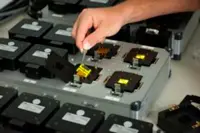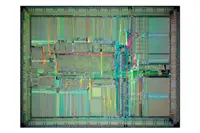Electronics News
Archive : 7 September 2015 год
 Antenova Ltd has built a model design for On Board Devices (OBD) and vehicle telematics. The OBD design is said to use three antennas inside an OBD housing to link to a satellite (GNSS), Bluetooth and a terrestrial network, whilst obtaining optimum performance from all three antennas simultaneously. The design also features a small GNSS RF module to fix location.
Antenova Ltd has built a model design for On Board Devices (OBD) and vehicle telematics. The OBD design is said to use three antennas inside an OBD housing to link to a satellite (GNSS), Bluetooth and a terrestrial network, whilst obtaining optimum performance from all three antennas simultaneously. The design also features a small GNSS RF module to fix location.
The latest antennas from Antenova’s product ranges are used in the OBD design including the Armata 3G FPC antenna for penta-band frequencies which operates at 824 to 960MHz and 1710 to 2170MHz, Bentoni - a GNSS antenna - operating at 1559 to 1609MHz, and the Weii PCB-mounted antenna which provides a Bluetooth connection at 2.4GHz.
The M10578 GPS/GNSS module is a complete receiver that provides location tracking for OBDs. It features the latest MediaTek chipset with an additional LNA to give added performance when mounted under dashboards and out of line of sight with the sky.
“We are demonstrating how a design for an OBD can give great performance, even when new antennas are added to an existing design,” explained Colin Newman, Antenova’s managing director. “OBD devices are growing fast in popularity, and the design of the RF components is critical to the overall performance of a device. In particular, Antenova’s engineers have invested many years in designing antennas that work effectively in very small spaces, whilst maintaining the efficiency of the antenna.”
Author
Tom Austin-Morgan
Source: www.newelectronics.co.uk
 Intel, Delft University of Technology and TNO, the Dutch Organisation for Applied Research, have embarked on a 10 year project to accelerate advancements in quantum computing. As part of the collaboration, Intel will invest $50million, as well as engineering resources and technical support.
Intel, Delft University of Technology and TNO, the Dutch Organisation for Applied Research, have embarked on a 10 year project to accelerate advancements in quantum computing. As part of the collaboration, Intel will invest $50million, as well as engineering resources and technical support.
"A fully functioning quantum computer is at least a dozen years away,” said Mike Mayberry, pictured, managing director of Intel Labs, “but the practical and theoretical research efforts we’re announcing today mark an important milestone in the journey to bring it closer to reality. Our collaboration … will explore quantum computing breakthroughs that could influence the industry overall.”
Intel has made the investment in the belief that no one company or organisation will succeed alone in developing quantum computing. Instead, it will require partnerships such as the one it has just entered.
“In the next five to 10 years, progress in quantum computing will increasingly require the combination of excellent science with high-level engineering,” said Lieven Vandersypen, lead scientist at Delft’s QuTech Institute. “For the realisation of complex circuits containing large numbers of quantum bits, the know how from the semiconductor industry is essential and QuTech is thrilled to partner with the leading semiconductor company in the world.”
Intel’s CEO Brian Krzanich noted: “Quantum computing holds the promise of solving complex problems that are practically insurmountable today, changing the world for the better.
“That’s a technology I think we’ll all be incredibly proud to play a part in developing.”
Pic: Mike Mayberry, managing director of Intel Labs
Author
Graham Pitcher
Source: www.newelectronics.co.uk
 Italy’s International School of Advanced Studies (SISSA) and Northwestern University, Illinois, are conducting a study into the development of a ‘multiferroic’ material that contained both elements of magnetism and ferroelectricity.
Italy’s International School of Advanced Studies (SISSA) and Northwestern University, Illinois, are conducting a study into the development of a ‘multiferroic’ material that contained both elements of magnetism and ferroelectricity.
Obtaining the two properties in one material to make sensors, computer memory and other components from is highly sought after. But, they have been shown to be almost entirely mutually exclusive: a material is either magnetic or ferroelectric, until now.
"Ours is certainly not the first attempt at obtaining a material of this kind, but up to this point there has been little in terms of satisfying results," Massimo Capone, SISSA researcher, said. "Our method is based on a surprising system." Capone and his colleagues' work is a theoretical study which will serve as a guide for developing the material itself.
"Our approach is based on creating a sort of sandwich with layers of Lithium Osmate, a ferroelectric metallic material, alternating with insulating material. Adding insulation causes magnetic properties to emerge from two non-magnetic materials. This heterostructure arrangement slows down electrons in the system, and it is this phenomenon that leads to the emergence of magnetism," explained Gianluca Giovanetti, SISSA/CNR IOM researcher.
"Our theoretical model shows a clear effect, and furthermore, we show that it is possible to control ferroelectricity with magnetism, another important property," concluded Capone. "The next step will be to test the material itself."
Author
Tom Austin-Morgan
Source: www.newelectronics.co.uk
 Researchers at Karlsruhe Institute for Technology (KIT) have received €1.7million funding from the Federal Ministry of Education and Research to develop printed electronics made of compostable natural materials and processes for industrial production.
Researchers at Karlsruhe Institute for Technology (KIT) have received €1.7million funding from the Federal Ministry of Education and Research to develop printed electronics made of compostable natural materials and processes for industrial production.
This is to combat the two million tons of electronic scrap being produced annually in Germany from products with printed electronics such as interactive packaging or smart plasters.
The researchers are using easily biodegradable materials such as plant extracts or gelatin to make semiconductors, dyes or insulators. “These may not be as long-lived as the inorganic alternatives, but they easily survive the service life of disposable electronics,” said Dr Gerardo Hernandez-Sosa, leader of the Biolicht Young Investigator Group of KIT. After use the electronics can simply be thrown away into the biowaste bin or on compost heaps, where it will rot like a banana skin.
So far, this has not been the case for conventional printed electronics, such as OLEDs. “We call all synthetic materials that are based on carbon ‘organic’. But this term does not tell us anything about environmental compatibility,” Dr Hernandez-Sosa explained. The carrier foil of OLED is made of the same plastic material as conventional drinks bottles.
One of the challenges the researchers face is how to produce compostable inks that will form the circuits. Environmentally compatible materials with the desired electrical properties have to be identified. For instance, hard gelatin - used for making drug capsules - is suited for insulation.
Contrary to conventional ink, it must not penetrate into the carrier material, but should form a closed liquid film on it without dripping off. A solvent that is too thick would plug the pores of the printer. A solvent too thin disperses on the carrier foil and does not cover it homogeneously. The properties of the dry material film are crucial to the function of the electronic components: Its thickness of less than a thousandth of a millimetre must not vary by more than 5%.
The researchers expect to have compostable organic electronics ready for the market within three years.
Pic: OLEDs can be produced easily and at low cost. Thanks to compostable materials, they are also made sustainable
Author
Tom Austin-Morgan
Source: www.newelectronics.co.uk
 China’s Loongson Technology has launched two quad-core processors based on the company’s GS464E 64-bit processor architecture, the Loogson-3A2000 and -3B2000. The two MIPS64 devices are said to execute both ARM and x86 instructions using LoongBT, a binary translation technology for Linux.
China’s Loongson Technology has launched two quad-core processors based on the company’s GS464E 64-bit processor architecture, the Loogson-3A2000 and -3B2000. The two MIPS64 devices are said to execute both ARM and x86 instructions using LoongBT, a binary translation technology for Linux.
The Loongson-3A2000 and -3B2000 are four-way superscalar processors built on a nine-stage, super-pipelined architecture with in-order execution units, two floating-point units, a memory management unit, and an innovative crossbar interconnect. The 3A2000 is said to be aimed at the high-performance consumer electronics market while the 3B2000 will be used in a number of home-grown eight and 16-core server systems.
The 3B series also features Loongson-3B1500, a MIPS64-based superscalar processor claimed to be clocked at 1.5GHz. Platforms integrating the3B1500 are alleged to deliver up to 192GFLOPS of peak performance at 30W.
Benchmarking data released recently showed the CPUs surpassing several competing processors in performance efficiency (SPEC CPU2000 per GHz), including ARM Cortex-A57 and AMD E1-2100. These performance figures also show a 2.7x improvement in performance over the Loongson-3A1000 and -3B1000 previous generation cores.
Author
Tom Austin-Morgan
Source: www.newelectronics.co.uk
 Diodes is buying analogue semiconductor company Pericom for $400million in a move which strengthens the former’s analogue and mixed signal connectivity portfolio.
Diodes is buying analogue semiconductor company Pericom for $400million in a move which strengthens the former’s analogue and mixed signal connectivity portfolio.
Dr Keh-Shew Lu, Diodes’ president and chief executive officer, said the deal will accelerate the company’s goal of hitting a $1billion annual revenue run rate. “This transaction broadens Diodes’ analogue footprint and adds a strong mixed signal connectivity offering that will drive expanded product content in target market applications. Also, Pericom’s extensive timing product lines complement Diodes’ standard product portfolio and broadens our analogue footprint.”
Alex Hui, Pericom’s president and chief executive officer, added: “Diodes’ size and scale provides an excellent platform for our products to gain access to a broader customer base and drive a higher level of growth than Pericom would be able to achieve as a standalone company.”
Author
Graham Pitcher
Source: www.newelectronics.co.uk

